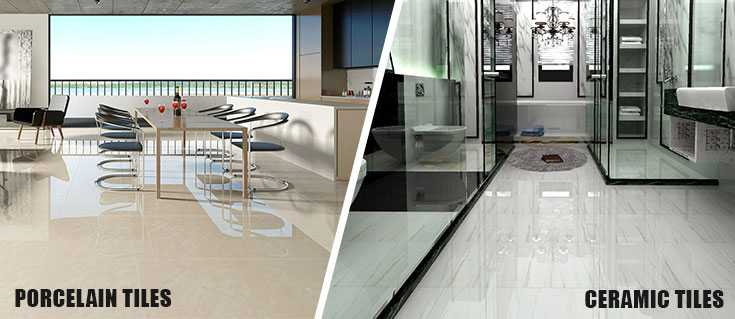You may have recently heard about ‘porcelain tiles’ as you started the hunt for some tiles to renovate or build your new home. Many wonder what’s the difference between ceramic and porcelain tiles? The words ‘ceramic tiles’ people often use to refer to a wide range of tiles. Sometimes they are even referring to porcelain tiles making the distinction even more unclear. But it’s important for you to know the difference between ceramic and porcelain tiles. The difference between the two is significant. Knowing the difference will help you make an informed decision for your new project.
What’s The Difference Between Ceramic And Porcelain Tiles? – Advantages And Disadvantages Of Ceramic Tiles
Ceramic tiles are the type of tile which people have produced for centuries since the middle ages. The ceramic body is baked in a kiln. They mostly come with glazing which adds beautiful colours and patterns to the surface of the tiles. Most tile manufacturers around the world are still producing ceramic tiles, including top Italian tile manufacturers. This is due to their comparatively low production costs. Also for their relatively easy installation process because of their softer body. Ceramic tiles are a great option for wall coverings as you will have a wide range of colour and pattern variations to choose from. They are light and also they are easy to cut and drill holes through.
At TFO, you’ll see some stunning ceramic wall tiles at by far the lowest prices in Sydney. One of the most popular ceramic tiles we sell is gloss white rectified wall tiles. These tiles are in a size of 300x600mm. They are extremely versatile making them suitable for any existing colour scheme in your room. The rectified edge allows you to have a minimum grout joint of 1.5mm which makes for a modern and sleek looking space.
What’s The Difference Between Ceramic And Porcelain Tiles? – Advantages And Disadvantages Of Porcelain Tiles
On the other hand, what are porcelain tiles? Porcelain tiles are a newer type of tile produced using the same principle as ceramic tiles. Manufacturers produce them with ceramics (or clay) which is more refined than that of ceramic tiles. Also manufacturers produce porcelain tiles at a much higher temperature than ceramics. What’s the result? Porcelain tiles have a much denser body compared to conventional ceramic tiles. That means they’re not nearly as porous as ceramic tiles and have almost no water absorption at all – just like glass. They’re obviously a lot stronger than ceramic tiles too once you securely install them.
What’s The Difference Between Ceramic And Porcelain Tiles? – Loads of Design Possibilities With Porcelain
Porcelain tiles have made many things possible that were previously impossible. For example, because porcelain tiles have extremely low porosity, manufacturers can produce them without a layer of glazing. Manufacturers can hone or polish porcelain tiles showing the original colour and pattern of the tile body. This has made it possible for tile manufacturers to produce tiles that nearly look like natural stone tiles. Polished or honed products that do not have a layer of glazing often have a depth in their character.
Porcelain tiles have also made it possible to produce large format tiles without increasing the thickness. The biggest porcelain tiles at TFO come in a 1.8m x 900mm size while the thickness is only 5.5mm. Other large format tiles such as 600x600mm and 800x800mm are also extremely popular. They are popular because they enhance the look of a room. They make it look more spacious compared to using smaller tiles.
Because of porcelain’s very strong body, its applications are also very versatile. Most commercial buildings prefer to use porcelain tiles for their durability. Many use porcelain tiles in outdoor areas as they can withstand many more damaging elements than ceramic tiles. Most porcelain tiles produced with outdoor use in mind have an R11 anti-slip rating. You should definitely look out for the R11 sign if you are looking for outdoor porcelain tiles.
Timber Look Porcelain Tiles
One type of porcelain tile that’s gaining momentum now is timber look porcelain tiles. Manufacturers usually produce them in sizes between 900x150mm to 1200x200mm. This is only possible because of porcelain’s strong body. TFO now deals with leading Italian tile manufacturers to source the world’s best timber look tiles. These are produced with innovative technology and sensational design philosophies.
Picking The Best For You
As you can see, while ceramic tiles have a very long history and manufacturers are still producing them worldwide, the innovation of porcelain tiles has brought much diversity to the tile industry. They both have advantages and disadvantages. So, it pays to consider the different performance of each tile to ensure that you are getting the look you are after while not neglecting the practicality that is essential to you. Most people decide after looking at all the options that porcelain tiles are the best option for them. However the choice is yours. Be informed.
Where To Buy
Here at Tile Factory Outlet, we encourage you to shop around as we are confident that you will come back to us in the end. We have by far the biggest turnover of stock in Sydney at our one location. We directly import products from manufacturers in Europe and then sell direct to the public at wholesale prices. We have friendly staff who have over 100 years of combined experience in the tile industry.
So there is no time to hesitate. Visit TFO today or go to our online tile store now.


